Inside the dark, unspoken world of exorcisms and deliverance in Victoria
Victorians desperate to cast out evil spirits are turning to exorcism and deliverance, with some priests conducting up to 10 a week. In this investigation, we take you behind the scenes of an unspoken world. See the video.
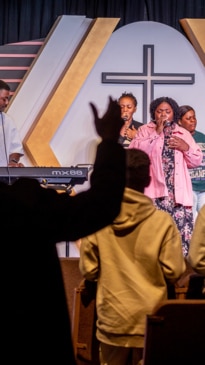
VWeekend
Don't miss out on the headlines from VWeekend. Followed categories will be added to My News.
It’s a Wednesday afternoon in an inner-northern Melbourne suburb. In a quiet neighbourhood, a mix of old weatherboard and triple fronted brick veneer homes line the street.
Standing outside an old church, marked by its cathedral stained glass coloured windows, you can hear distant laughs of children riding their bikes.
You see mums pushing babies in prams.
But inside the church it’s anything but calm.
A woman speaks in sinister tongues, fiercely growling. Then she suddenly falls to the ground from the church pew, her body shaking uncontrollably.
“Demon, out of her,” a pastor commands.
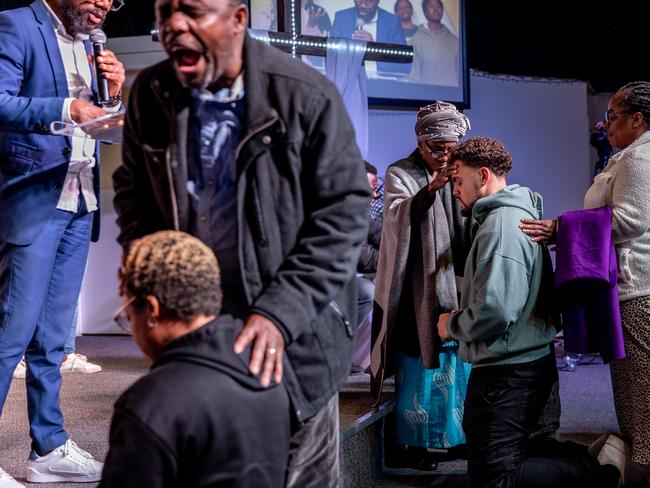
It’s an act of “deliverance”, an intervention to cast out evil spirits that the pastor and others like him believe will help those experiencing paranormal and supernatural events.
In more extreme and rare cases, religious leaders use the ritual in the belief they will help someone possessed by a demon.
Many may think exorcism and deliverance are confined to movies and novels, but they are reported to be on the rise in Victoria, with some pastors and priests conducting up to 10 a week.
While not everyone is on board, with some exorcism and health experts warning of the serious dangers involved, during a three-month V Weekend investigation we delved into the dark and often unspoken world of exorcisms and deliverance, meeting exorcists and pastors conducting centuries-old rituals and the people who say their souls have been saved.
Catholic priest Father Michael Shadbolt, 85,is wearing glasses and dressed in a traditional white vestment with a purple stole.
The imposing figure slowly walks into the foyer of a church presbytery in Melbourne’s southeast holding a red prayer book close to his chest.
Alongside him is a man in his early 30s.
He wipes tears from his eyes with his hands. “Thank you, Father,” the man says with relief.
A quietly spoken Father Shadbolt replies: “I will pray for you.”
The man has just inquired about an exorcism. He has also received a prayer for spiritual guidance.
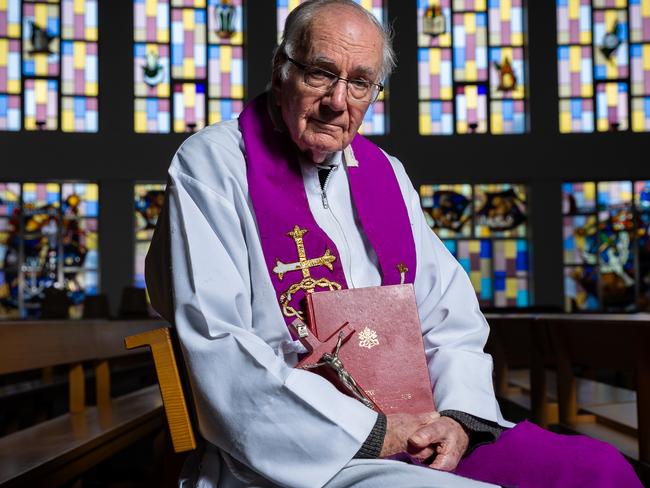
Ordained as a priest 60 years ago, Father Shadbolt, who is now retired, was appointed as Melbourne’s official exorcist by former Archbishop Denis Hart in 2011.
We are seated in a small room inside the presbytery. Beside Father Shadbolt is a small table with holy water, a large cross and a prayer book.
“I didn’t know much about it, so former Archbishop Hartgave me the ritual and I started praying (that) over people,” he says.
“I soon found out that some reacted under the prayer while others didn’t and I would say to those that reacted, ‘Come back, same time, same place next week.’
“I would continue to pray for them as long as it took to remove those manifestations.
“I also read about some of the leading exorcists in modern times such as Father Gabriele Amorth … and I kept doing this after I retired because people kept coming.”
To perform exorcisms within the Catholic Church, a priest must be appointed or authorised to do so by an Archbishop.
“Anyone, whether or not they are Catholics, should make sure that any priest doing this has this authority,” Father Shadbolt says solemnly.

It can sometimes take weeks, months or even years to remove the evil entity, he says, adding there is a careful procedure to identify if the person is indeed possessed by an evil spirit.
Father Shadbolt sits back in his chair and explains the seriousness of performing exorcisms on people with mental health issues.
“These issues are a big concern in the ministry for exorcism. You have to be careful not to tread where only psychologists and psychiatrists should go.
“I don’t pray for people who have serious mental health issues, if they insist (on an exorcism) I say get me a letter from your doctor.
“I don’t think the prayer would hurt them because it’s only a prayer, but it could frighten them or it could cause them to abandon their medication thinking they were cured, but that would be very dangerous.”
Father Shadbolt opens his red prayer book. “This is the more recent ritual,” he says.
He then holds up worn sheets of paper.
“This is a copy of the 1614 ritual, which I use with some modifications.”
The Rite of Exorcism prayer can induce manifestations, when demonic forces possessing a person show themselves.
Other phenomena might include spiritual oppression, obsession and vexation.
“You’re reading (the prayer) and all of a sudden a person starts screaming and shaking all over, they might dry retch or roll around on the floor.
“Commonly, it’s the look of sheer hatred. It can be very scary at times, the hairs on the back of your neck can stick up,” he says.
An exorcist must keep calm and refrain from dialogue with manifesting spirits, he insists.
“The power is in the prayer and the power of Jesus,” he says.
But Father Shadbolt says with time “you get used to” the confronting nature of exorcisms.
He also says he goes about the process as “ethically” as possible.
“We don’t tie anyone up, that’s not a practice used here in Australia. If a woman falls on the floor, my assistant will put a blanket over her.
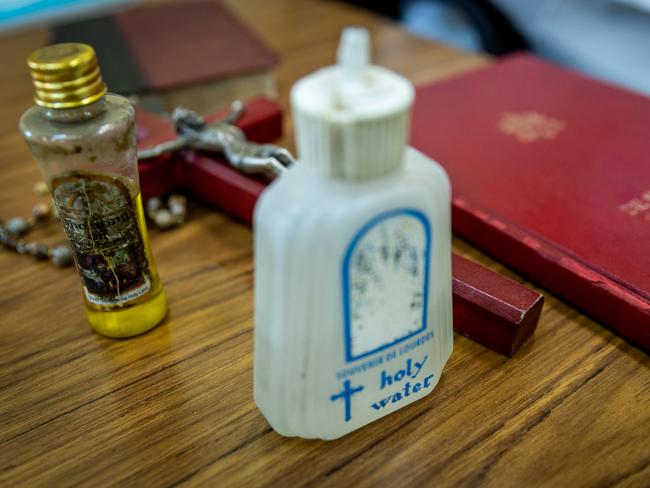
“Apart from laying hands lightly on the head or shoulder of the person you’re praying for, you don’t touch them at all.”
He says many people seeking exorcisms had previously dabbled in “occult practices”.
“It might be tarot card reading … Some people have even made pacts with the devil and they’re suffering some effects from that.
“As a rule they don’t manifest, but in some way they’ve probably opened the door to something. Some people come along to me who aren’t believers but they’re troubled by evil spirits. I remember praying for one person who wasn’t a believer but he turned out to be possessed.”
Shadbolt says there are many inaccuracies in Hollywood’s depiction of exorcisms, including “exaggerating” the manifestations.
“A misconception is that doing an exorcism would be pretty scary or exciting. By and large the work is very boring.
“Imagine saying the same prayer that goes for 20 minutes or half an hour. It is not often that you get someone to react under prayer.
“But when it does happen, it can be truly frightening.”
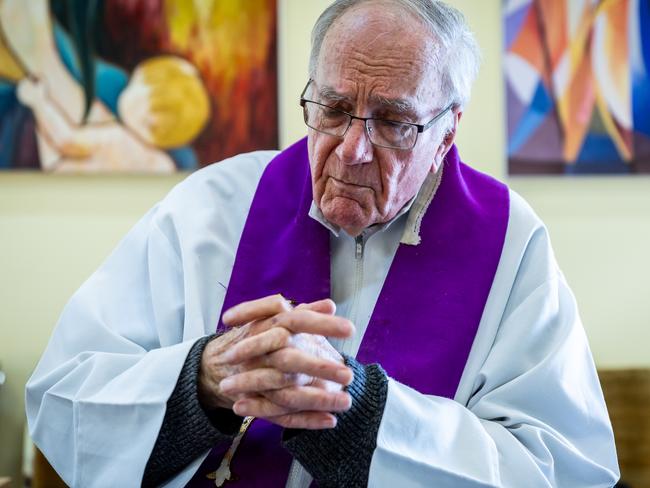
He also stresses Catholic exorcists are encouraged to be sceptical at all times.
“The only proof that an evil spirit might possibly be present is if the person gets better as a result of the prayer.”
Despite conducting dozens of exorcisms and encountering the supernatural, he stresses that he’s just an “ordinary Aussie priest”.
He wrote a book during Victoria’s Covid lockdowns titled Exorcism – Reflections of an Australian Catholic Exorcist to help other priests think about taking part in the ministry.
“Some priests have been appointed but they haven’t kept it going very long and the reason for this is they haven’t got a good method.
“It’s my hope that more priests are appointed to the exorcism ministry.”
Apprentice exorcist and Mildura-based
Catholic priest, Father John Corrigan, is among a new generation ensuring the fight against evil can continue, studying for five years under the mentorship of another priest and including visits to Rome for further study.
“I have been able to use the master apprentice model … I do get a lot of people calling because early on I had a bit of an online presence as an exorcist,” Corrigan says.
“In my experience, if people did need deliverance, they weren’t possessed.
“Some of them were suffering from infestation or obsession.
“I’ve had a lot of infestation where you go into the house and it’s freezing cold in one area of the room and there’s animal sounds.
“I’ve been able to pray the prayer in those circumstances.
“But actual exorcisms, they’re only for people who are possessed and I haven’t come across anyone that’s experiencing this. It’s quite rare in this country.”
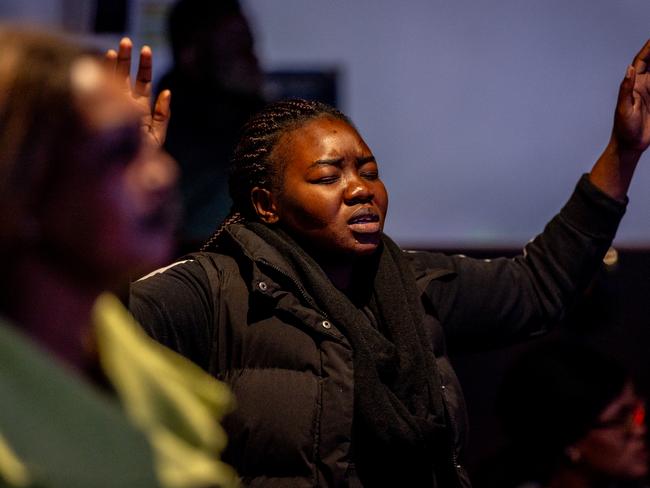
Corrigan says he had once been of the view that someone needed either an exorcist or a psychologist.
“It’s not that simple at all, it’s not either/or and very often people do need mental health care but they also need spiritual care.
“I think when someone is presenting with a personality disorder you have to tread very carefully. I’ve asked a few clinical psychologists if you could do harm to someone if they have religious mania to be prayed over and they say if you’re managing expectations there’s not a lot of harm.”
Corrigan believes anyone who conducts an exorcism outside the guidelines of the church is exposed to greater danger. “That means the priest himself is not the primary minister, the church is administering this service to a person. It’s the whole church that prays but that protects the exorcist from any retaliation.
“Whereas a non-Catholic who attempts an exorcism, they’re going to be much more exposed to retaliation. The biggest difference between exorcism and more general deliverance is that exorcisms done by non-Catholics or others, you’re directly addressing the evil spirits, satan and the other demons.
“Whereas deliverance in the Catholic tradition is addressed to God, Our Lady and the saints … so you’re asking them for protection, you’re not engaging with the devil.”
Corrigan warns exorcisms performed by ministers who are “unregulated” and “badly trained” can be dangerous.
“People die from exorcisms,” he says, citing the tragic death of Victorian woman Joan Vollmer in 1993. Joan died after her husband, pig-farmer Ralph Vollmer and three others carried out a series of rituals on her.
Ralph first noticed his wife Joan was behaving strangely a few weeks before the group decided to stage the violent, four-day exorcism that led to her death.
“That would never have happened in a Catholic Church, it was devastating,” Corrigan says. He adds that his beliefs on what makes a “good exorcist” have changed.
“I used to think that exorcists had to be very holy priests, but Father Gregory Jordan who was an exorcist in Brisbane and died a few years ago said an exorcist must be wise, be prudent and have common sense.
“They can understand when prayers are needed and when other things are needed.”
Oracle Ministry Pastor Maurice Chapman sits in front of a church altar in Thornbury.
He is neatly dressed in a red shirt and black pants. Rays of coloured light flow through the stained glass windows. But what he is about to speak to us about is dark and at times confronting for casual observers.
His ministry is an independent Pentecostal church, specialising in “healing through deliverance”.
“The Catholics call it exorcism, we call it deliverance. They are the same thing basically, exorcising demons or delivering people from demonic oppression and often possession,” he says. “We believe in the charismatic gifts of the Holy Spirit, we believe in healing, prophecy and all those things.”

He believes some people who become oppressed “physically manifest” through sickness, with some “demons taking up residence” inside a person.
“Deliverance is leading the person to repent and confess all their sins to Jesus Christ. Then all demonic legal rights are removed and evil spirits are cast out.
“When all legal rights are taken away, there’s no reason for that unclean spirit or demon to remain, it must go. Legal rights are sins and Jesus forgives all confessed sins.”
Chapman, who has been conducting deliverance sessions for 14 years and has been in full time ministry for almost 30 years, says he does at least four deliverance sessions a week. V Weekend observed footage of two deliverance sessions conducted by Chapman.
One of these women, “Ruth”, reveals she has been feeling “spiritually and mentally sick”.
Chapman commands: “Out of her, in the name of Jesus Christ” as he places his hand on her shoulder and prays over her.
Ruth rolls on the floor side-to-side, screaming as if she is in sheer agony. It is evident a fierce battle is taking place.
Frighteningly, she also speaks in tongues as Chapman continues to pray over her. He tells us they are “demonic tongues”.

After her deliverance, she reveals she had been “sick for months”, but she is now “free”.
“I was going back and forth to the hospital for stomach pain, but today I came to Pastor Maurice and I have been truly healed, freed and blessed.”
In another deliverance, “Sarah” sits with her family on a church pew. She is in her mid-30s. Her arms are crossed and she looks down.
While holding in tears, Chapman leads her through prayers of renunciation. She believes she has been oppressed by demons since she was a teenager.
After a few minutes of Chapman praying, she falls to the floor, rolling erratically. The pastor then holds a cross above her.
“Don’t you hurt her, get out of her,” he commands. It becomes even more intense as Sarah begins vomiting into a bin.
A few minutes later, she sits back up.
Chapman asks her what the demon said. She responds: “He doesn’t like you, he wants to kill you.”
After the session, Sarah is visibly shaken, but although tired, she says she is “finally at peace”.
She thanks Jesus and Pastor Maurice for “delivering and saving her”.
Young couple Neeraj and Tamanna, who are in their early 30s, underwent deliverance by Chapman in mid-July.
Neeraj traces paranormal occurrences back to his wife’s family home in India.
“This all started about 13 years ago in India. My wife’s family started to hear footsteps in the house and then things intensified when gold and other valuables started going missing,” he says.
The couple married and shortly after moved to Adelaide in 2017.
“Things started to quieten down back in India but it wasn’t the same here,” he says.
“We lived in a unit and strange things started happening including a framed photo of our wedding falling down during the night. I would put it next to the door of our bedroom and in the middle of the night, the frame would fall again and the door would open by itself.”
In 2020, the couple moved to Melbourne’s northern suburbs. They say more “unexplained” and “supernatural” events continued to occur.
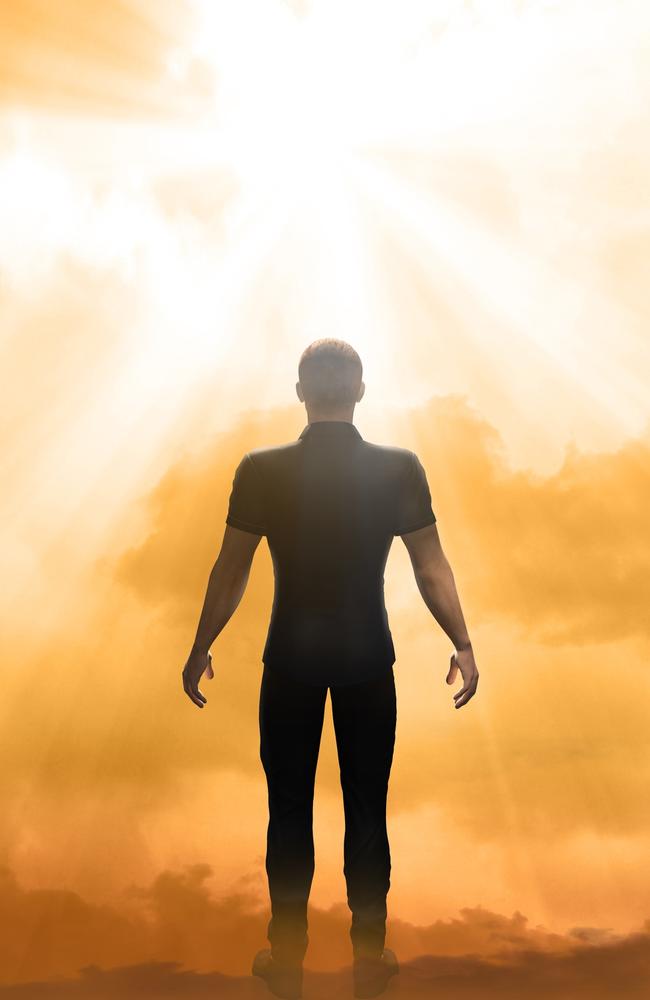
“My wife was sitting in the master bedroom and she felt someone walk past, but there was no one in the room. Toys would also start turning on by themselves in the middle of the night.”
Neeraj believes he also started to “feel a presence” in the house.
“When I was sitting on the couch, I would feel this heavy force sitting next to me. I felt completely scared,” he says.
“My wife then began to feel tormented and this is the very first time that the demons began to severely torment her since leaving India.
“We felt like everything we had done to work hard here in Australia was all useless.”
Over the next year or so, Neeraj began contacting psychics, healers, shamans and other spiritual workers. This cost him thousands of dollars. He says “nothing worked” and the attacks “intensified”.
“I then met up with Pastor Maurice and this was a turning point for us about 15 months ago. He explained the spiritual situation and showed us videos of deliverances and there were people shouting and vomiting and my wife got scared.”
Neeraj says things got even worse as his wife began manifesting “evil spirits”.
“We then converted to Christianity. We were worshipping at a church last Good Friday and my wife began shouting ‘stop it, stop it’, in Hindi.
“Later on we started commanding and it (the spirit) said ‘I will kill her’, ‘I will take her’ and this was in front of 30 people.”
The couple say they then contacted Oracle Ministry and “put their faith in Jesus Christ” through Pastor Maurice to “deliver” them.
“He told us the spirits won’t leave until we repent and confess our sins to Jesus.
“We realised one of the strong spirits was a generational spirit as my mother-in-law and my wife’s sisters were also affected.”
Tamanna’s mother Kusu, who has joined the interview, begins sobbing and speaking in Hindi as she recalls the recent intense deliverance.
Neeraj begins to translate for her.
“Thank you, lord, for bringing us out of the pit and thank you, pastor, for helping us,” Kusu says.
Neeraj adds: “We used to be the ones who hated Christianity but now we know that Jesus Christ is the one and true living God who saved us.”
Pastor Maurice agrees with Father Shadbolt that dabbling in the occult can be dangerous.
But he goes a step further, warning practices such as witchcraft, new age yoga and meditation can be “portals that demons pour in through”.
The pastor stresses that he can make a “distinction” if someone is spiritually oppressed or has mental health issues. He also says he takes the mental health of those seeking help “very seriously”.
“It’s easy for me to tell if this is a person or if this is a demon, it’s called discerning of spirits,” he explains.

Chapman says when someone “manifests” it is because “the evil and unclean spirits” have a strong reaction to the prayers.
“They begin to gag, vomit and manifest and the person can’t go on because this thing is preventing them and trying to shut them down.
“They have to really fight. But most of the time they are unable to do it by themselves, so they come to a deliverance minister.”
When asked if performing deliverance is confronting, Chapman confidently says “no”. He felt “called” by God to do it.
“I protect myself with the blood of Jesus Christ,” he declares. Chapman adds his purpose for undertaking deliverance ministry is to set people free.
“Their expressions change, you see the joy and the peace that come into their heart and I want to bring them closer to Jesus, because after all, it’s their eternal life that is at stake. This is why I do it and to bring glory to God.”
In a street in an industrial area on the outskirts of Melbourne’s southeast, there are car dealerships and auto repair shops.
If you were looking for a church at first glance, it would be hard to find. There are no large buildings with a cross, tower or dome. Instead, there is a large, factory-like grey building with a gravel car park.
As you walk up to the entrance, you can hear gospel music from inside. It’s a Wednesday night and Pastor Joseph Wisdom Sesay is about to hold a group deliverance at Cross Purpose Church in Cranbourne.
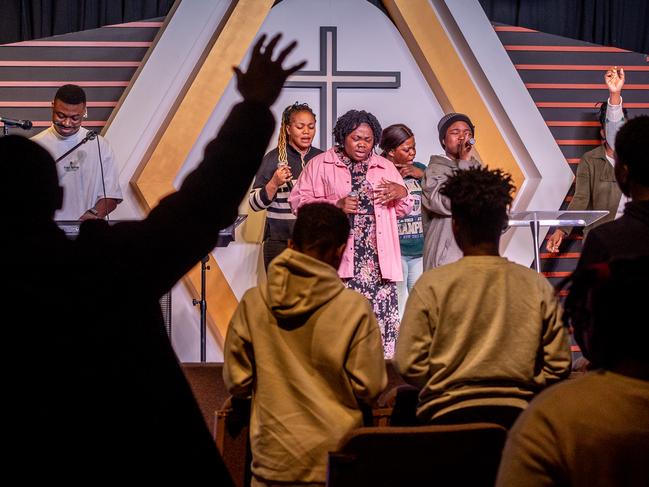
We are immediately greeted by parishioners and sit close to the church’s main stage. A female preacher begins addressing churchgoers. Behind her is a youth band and group of singers.
“When you believe in your most highest God, miracles take place,” she says.
After almost 10 minutes, the whole congregation begins singing: “Let your will be my will.” Midway through, Sesay, who has been performing deliverance for 20 years, takes the microphone.
He tells people inside the congregation: “I really feel an anointing being released in this place. There is some power in this room. There is power in this place for deliverance.”
Churchgoers begin waving their hands in the air and continue to sing. The music gets louder and the preaching becomes stronger.
“We come against the power of darkness,” Sesay says.
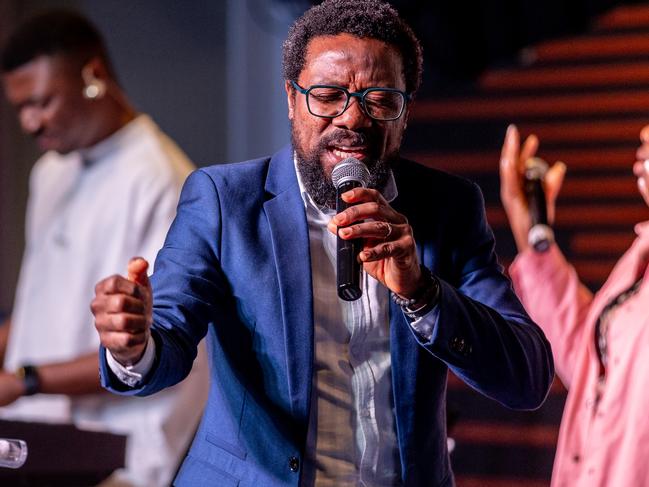
A woman falls to the floor and begins shaking. In front of her, another woman also falls to her knees. A church helper then passes a bucket to another man as he vomits.
A group of young people, mostly in their early 20s, approach the stage. They kneel as they are prayed for and receive deliverance.
A woman places her hand on a young man’s forehead. She supports him through the process. Another man falls to the ground uncontrollably shaking. Church helpers and another pastor quickly rush over to help him.
Sesay says he conducts up to 10 deliverance one-on-one sessions a week.
“We have this deliverance service because people want to feel they are present, that they are in the moment,” he says. “Sometimes people travel from interstate to come just for this time, to be prayed on and anointed with oil.”
Sesay says there are “six levels” of spiritual affliction.
“When we talk about deliverance, people are confused and question if they are possessed but I would use the term spiritual affliction, (which) runs from oppression, obsession to possession.
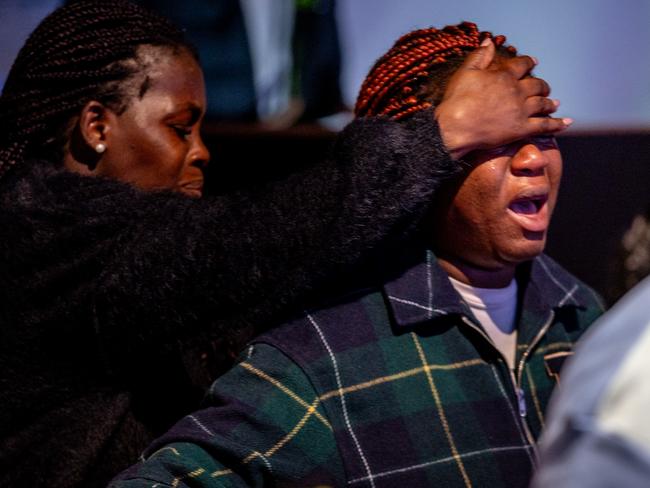
“Possession is the extreme … we have different levels for someone to come to this place. We’ve seen things that words cannot express, that the mind cannot conceive. People being taken over, manifesting, we’ve seen demons speaking through people.
“We’ve seen people growling like animals … they change and become like monsters.”
He says there has been a “significant rise” of deliverance rituals after Covid.
“Right after Covid I would have up to 12 people seeking help. I believe that those moments during Covid erupted a deeper sense within people – there’s been an awakening.
“When someone explains their affliction, the worst you can do is not to validate what they are saying, to tell them it’s in their head.”
Sesay adds that Hollywood is full of misconceptions when portraying exorcisms or deliverance in films.
“It gives people the impression that it’s crazy stuff, people flying, hitting the walls … the reality is not that and I think one of the things that scares people is that. “I don’t use the word possession often because it’s not really in most cases, I use the word spiritual affliction.”
He adds it’s a “mandate” for him to help people through his deliverance ministry.
“It’s my purpose to bring freedom, restoration and transformation, that’s why I am in Australia.
“I do this because the spirit of the lord is upon me. This is the commission that the spirit of God has given me.”
Professor Sarah Ferber of the University of Wollongong, an expert on the history of Christian exorcism, says exorcisms are on the rise amid their depictions in mainstream films and popular culture.
“It seems to have been given a huge boost since the early ’70s by The Exorcist book and film, which were basically just very successful missionary work,” Ferber says.
“It’s also part of a general trend towards a more charismatic style of religion, calling directly on God, among Catholics and Protestants alike.
“It seems that the greater the exposure of exorcism, the more likely it is to catch on. “But it also has active promoters: Father Gabriel Amorth in the Vatican urged all of the last three popes to have the church do more exorcisms,” she adds.
She says the greatest risk of exorcism is death, saying dozens of people have died, including Joan Vollmer.
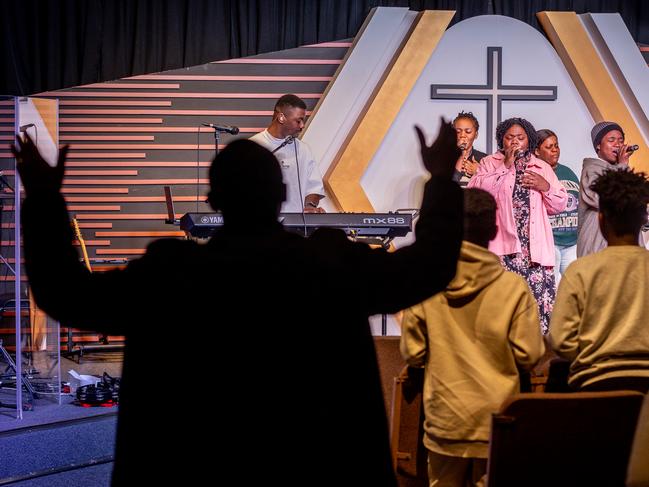
Ferber has researched the Vollmer case with legal expert, Dr Adrian Howe.
“More than 30 people have now died because others believed they were defeating the devil, when they were actually assaulting a human being,” Ferber says.
“Exorcisms are absolutely not a form of health care: they are an act of devotion on the part of the exorcist, who wants to worship God and show others that God has responded to them.”
She says the exorcist’s goal is that the person treated, along with any witnesses, will then also give thanks to God.
“They might mean well and of course they are entitled to believe anything they wish, but exorcisms are getting into dangerous territory that most of the mainstream churches are rightly very hesitant about.”
Ferber adds if someone has a mental health issue, they need to see a doctor or counsellor who would not ordinarily sign off on exorcisms.
“Some certainly would,” she says.
“But if they do, they cross the line between their private belief and their scientific training. Someone with a mental health issue needs to see a trained expert with no interest in evangelising as a form of health care.
“There are plenty of helplines that people can use, without having to undergo an aggressive religious ritual. Not every mental illness can be cured even by modern medicine, but there is no evidence any can be cured by exorcism.
“An exorcism is an intervention that is purely moral not psychological.”

University of Melbourne head of psychiatry Professor Christopher Davey says his major concern with exorcisms is that they are “historically directed” at people with mental illness.
“This was when we knew much less about mental illness and my sense is that a lot of people in the past would have had illnesses like schizophrenia, bipolar disorder and epilepsy and were subjected to exorcisms that were likely to have been quite damaging to them,” Davey says.
“There probably were some people who developed distress that wasn’t at the level of what we would consider mental illness, and where they could understand it in the context of their religious beliefs, and where exorcism might have been helpful for them.”
Davey says unexplained behaviour such as “manifestations” could be a result of someone becoming “regressed” and entering a “suggestible” state.
“This could make them act in those sorts of ways … I would really encourage family members when they are worried that a person close to them shows signs of a more serious mental illness that they see a clinician to at least rule that out before undergoing an exorcism.
“You need to respect people’s idiosyncratic and religious beliefs and sometimes it is a fine line between what might be considered illness or a manifestation of a spiritual crisis.
“But for many, by pursuing an exorcism they’re not really getting the help they need,” he adds.
University of Melbourne Professor David Coghill, the Financial Markets Foundation Chair of Developmental Mental Health Departments of Paediatrics and Psychiatry, says people undergoing exorcisms or deliverance could be experiencing “dissociation”.
“They feel detached in some way from their bodies, thoughts or surroundings, they perceive things to be different than we see them objectively,” Coghill says.
“Of course people with major mental health problems can hear voices, they can have hallucinations, they can have beliefs that other people would recognise as untrue.
“People that experience trauma often get these dissociative experiences and when you experience them they are real … they are real experiences but they will recognise them as not being usual for them.”
Coghill says people should be free to seek spiritual support, but he would also encourage them to think about help from medical professionals.
“I just wouldn’t see it as an either/or situation because we shouldn’t deny people their spiritual or religious freedom to seek the support they want but also they shouldn’t be denied mental health care.”



